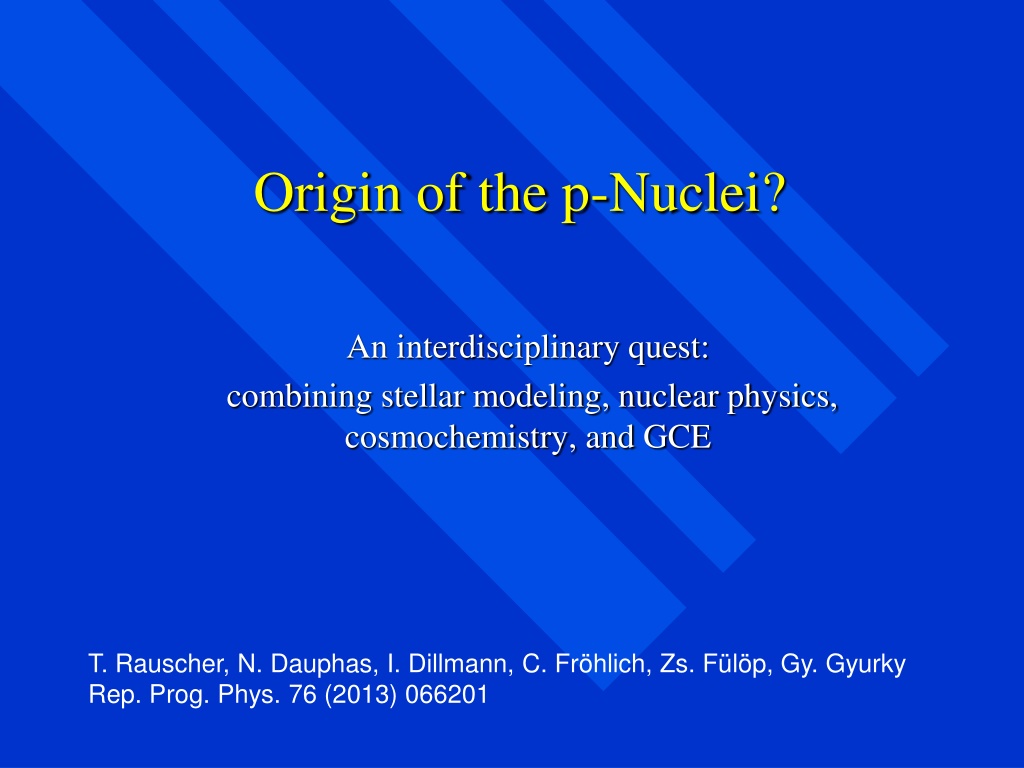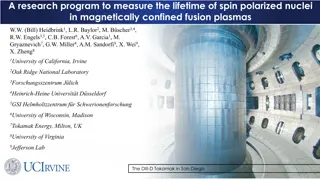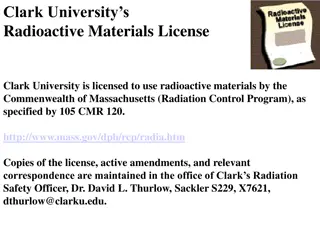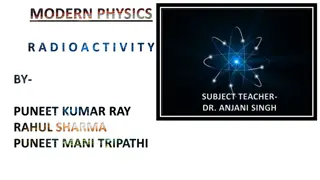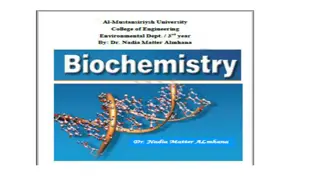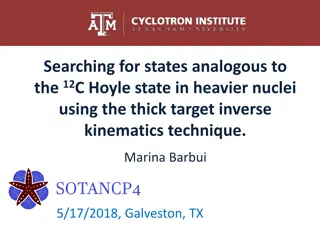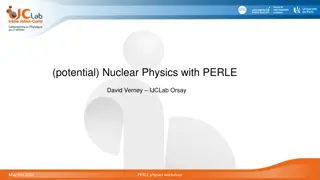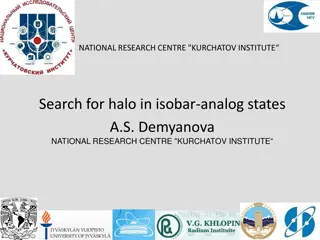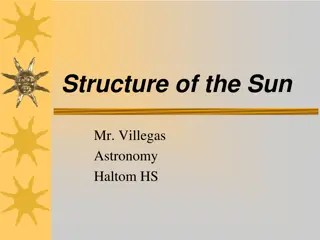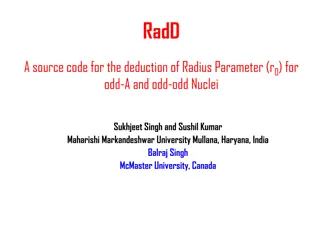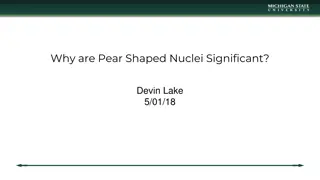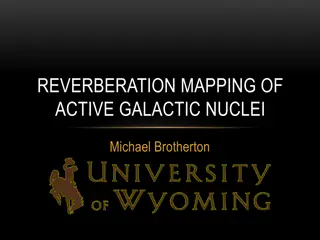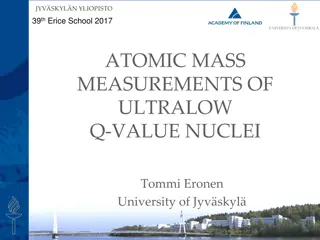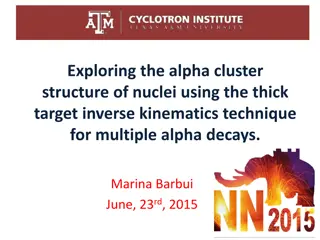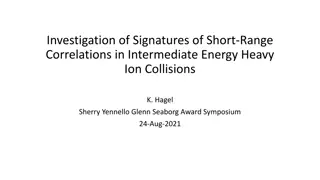Understanding the Origins of p-Nuclei: An Interdisciplinary Exploration
The study delves into the origin of p-nuclei, which are not produced by s- and r-processes. It discusses their scarcity, involvement in stellar processes, and potential production mechanisms like the p-process. Various scenarios and challenges in explaining the abundance of p-nuclei are also elaborated, shedding light on the complex nature of these elements.
Download Presentation

Please find below an Image/Link to download the presentation.
The content on the website is provided AS IS for your information and personal use only. It may not be sold, licensed, or shared on other websites without obtaining consent from the author. Download presentation by click this link. If you encounter any issues during the download, it is possible that the publisher has removed the file from their server.
E N D
Presentation Transcript
Origin of the p-Nuclei? An interdisciplinary quest: combining stellar modeling, nuclear physics, cosmochemistry, and GCE T. Rauscher, N. Dauphas, I. Dillmann, C. Fr hlich, Zs. F l p, Gy. Gyurky Rep. Prog. Phys. 76 (2013) 066201
p-Nuclei Def.: What is not made by s- and r-process Originally 35 proton-rich nuclei assigned but: p- time-dependent definition perhaps fewer (s: 113In, 115Sn?, 152Gd, 164Er, ) Tiny abundances, no element dominated by p-abundance no stellar abundances Tiny reaction cross sections Few nuclei involved, but also only few simulations and measurements (astron, nuclear) available
p-Process Def.: What makes the p-Nuclei One or several manifestations ? Possibilities to get to the proton-rich side: From below : proton captures hindered by Coulomb barrier, competition with photodisintegration high proton densities required From above : ( ,p), ( , ), decay From neutron-richer nuclei: ( ,n) favored in photodisintegration of near-stable nuclei What can be varied? Proton abundance/density Explosive conditions (temperature-density history) Seed nuclei! (secondary process)
Popular Scenarios Currently favored: -process in O/Ne shell of massive stars consistent p-production across large range of nuclei deficiencies for A<100 and 150<A<165 additional -process for 138La and 180Ta Explosion of mass-accreting white dwarf regular SN Ia and/or sub-Chandrasekhar WD combination of p-captures and -process (and np-process) Problems: requires seed enhancement, sensitive to details of the hydrodynamics Extremely p-rich scenarios: rp-process, p-process decay of p-rich progenitors problem: detailed modelling, ejection, Nb/Mo ratio in meteorites puts tight constraint
The -Process Photodisintegration of seed nuclei (produced in situ or inherited from prestellar cloud). NOT total disintegration, of course! (just the right amount) Explosive burning in O/Ne shell in core-collapse SN Woosley & Howard 1978; Prantzos et al 1990; Rayet et al 1995
The -Process Photodisintegration of seed nuclei (produced in situ or inherited from prestellar cloud). NOT total disintegration, of course! (just the right amount) Explosive burning in O/Ne shell in core-collapse SN Woosley & Howard 1978; Prantzos et al 1990; Rayet et al 1995
Nuclear Reactions Under -Process Conditions Time-dependent density and temperature profile (self-consistent or parameterized) Different layers with different peak temperatures: light p- elements produced at high temperatures, heavy at low ones Temperatures similar in other scenarios (not too much photodisintegration allowed!)
Photodisintegration of stable seed nuclei Not an equilibrium process! Competition of ( ,n), ( ,p), ( , ) rates determine path and destruction speed at each temperature. Strong nuclear constraints on required astrophysical conditions for each group of nuclei, e.g., at high T all heavier nuclei are destroyed.
Example of Reactivity Field low Z ( ,p)/( ,n) competition important at low Z ( , )/( ,n) competition important at high Z ( , ) uncertain because of uncertain optical potential at low energy only first uncertainty in each isotopic chain (coming from stability) is relevant!! Uncertainties: diamonds: rate competitions high Z
Nucleosynthesis Results (15 Msol) Production factor A Rauscher et al. 2002
p-Production in Massive Stars Site: Explosive O-shell burning in core collapse SN Seed: s- and r-nuclides, either already existing when star formed or produced (weak s-process) during stellar life Underproduction of Mo-Ru region always found (no sufficient seed abundance to disintegrate) Dillmann, Rauscher et al 2008 KADONIS v0.2 Woosley & Howard 78
p-Production in various stellar models Depends on progenitor mass Depends on initial metallicity Already new Lodders abundances lead to some differences due to big 16O differences and different pre-SN evolution (mostly in He-burning) Rep. Prog. Phys. 76 (2013) 066201 Rauscher et al 2002
-Process Path Deflections deflection point ( ,n) determine timescale ( ,p/ ) determine flow to lower mass Mo quick change in dominating reaction within isotopic chain mostly only competition between ( ,n) and one other particle channel primary targets for experimental investigation (but unstable!) Pd ( ,n), ( ,p), ( , ) rates at T9=2.5 for Z=42-46 (Mo-Pd)
Relevant Nuclear Input General p-Process Properties: Temperatures of 2<T9<3.5 (depending on scenario) Starting from s- and r-nuclides (previously included in star or produced by star), dominant flows are ( ,n) With decreasing proton- and/or -separation energy, ( ,p) and ( , ) become faster: deflection of path ( branching ) For light p-elements, (n, ) can hinder efficient photodisintegration (n,p) reactions can speed up matter flow Some scenarios: proton captures in mass region of light p-nuclei Rapp et al 2006
Galactic p-Evolution p-Abundances result from many events: Have to integrate stellar yields over IMF (initial mass function, mass distribution of stars in galaxy) Additional uncertainty Here, yields from stars with different masses but same (solar) metallicity are shown. Arnould & Goriely 06
A & G 2003 Massive star yields averaged over IMF (Lodders abundances) p-Underproduction for A<130 still some problems at higher masses Woosley & Heger 2007
Popular Scenarios Currently best studied: -process in O/Ne shell of massive stars consistent p-production across large range of nuclei deficiencies for A<100 and 150<A<165 additional -process for 138La and 180Ta Explosion of mass-accreting white dwarf regular SN Ia and/or sub-Chandrasekhar WD combination of p-captures and -process (and np-process) Problems: requires seed enhancement, sensitive to details of the hydrodynamics Extremely p-rich scenarios: rp-process, p-process decay of p-rich progenitors problem: detailed modelling, ejection, Nb/Mo ratio in meteorites puts tight constraint
p-Synthesis in canonical SN Ia and sub-Chandrasekhar WD explosions Howard, Meyer, Woosley 1991 explosive burning of matter accreted from companion high density, high proton density, high T possibly combination of p captures and photodisintegration may become initially neutron rich possible seed enhancement by previous s-processing in AGB companion large enhancement required exact conditions unknown (multi-D) Goriely et al 2002 Wallace & Woosley 1981 Howard, Meyer, Woosley 1991 Goriely et al 2002 Travaglio, Roepke et al 2010
Popular Scenarios Currently best studied: -process in O/Ne shell of massive stars consistent p-production across large range of nuclei deficiencies for A<100 and 150<A<165 additional -process for 138La and 180Ta Explosion of mass-accreting white dwarf regular SN Ia and/or sub-Chandrasekhar WD combination of p-captures and -process (and np-process) Problems: requires seed enhancement, sensitive to details of the hydrodynamics Extremely p-rich scenarios: rp-process, p-process decay of p-rich progenitors problem: detailed modelling, ejection, 92Nb in meteorites puts tight constraint
Schatz et al 1999 92Nb cannot be reached by decays Live 92Nb found in presolar grains tight constraint on contribution from p-rich side (Dauphas et al 2003) p-process Pruet et all 2006; Fr hlich et al 2006; Weber et al 2009
Meteorites allow us a hands- on study of stellar matter! Two types of interesting contributions to presolar cloud: 1. Presolar grains: Each grain is from a single star! Found in special types of meteorites; allows isotopic analysis. 2. Extinct radioactivities: Traces of long-lived radioactive isotopes from stellar sources just before freeze-out of pre-solar cloud; extracted from bulk meteorites; summed contributions from many stars. Important information on p- nuclei: Bulk SS values Early SS values Isotopic anomalies in grains and bulk adapted from M. Lugaro
Meteoritic Grains s process constraints: from meteoritic silicon carbide (SiC) grains that formed in the expanding envelopes of carbon stars (AGB) and contain trace amounts of heavy elements showing the signature of the s process. Other types of grains formed in stellar wind from massive stars and in SN remnants High-sensitivity laboratory measurements of the isotopic composition of trace heavy element in single grains of the size of micrometers provide constraints of precision never achieved before.
Analysis of presolar grains found in meteorites SiC grain NanoSIMS at Washington University, St. Louis F.J. Stadermann, http://presolar.wustl.edu/nanosims/wks2003/index.html
Traces of decay products of long-lived but already extinct radionuclides are preserved in meteorites containing untainted material from the early solar system. 146Sm
Extinct Radioactivities in Bulk Meteorites Isochrone Definition:
Open-Box GCE model: 3-phase ISM mixing model: half-life Nb and Sm data are consistent and constrain the free parameter of the GCE model. This excludes 92Mo contributions from processes not making 92Nb! But: Based on current production ratios! Problem with 146/144Sm ratio?
Problem with +144Sm Potential [1] McFadden & Satchler Pot. [2] Avrigeanu Pot. I [3] Mohr & Rauscher 98 Pot. [4]+exp: Somorjai et al. 1998 144Sm( , )148Gd Somorjai et al, A&A 333, 1112 (1998)
(Low energy) Coulomb excitation compound inelastic direct inelastic scattering = Coulomb excitation ' T. Rauscher, PRL 111 (2013) 061104 ' compound elastic Compound formation + reaction direct elastic scattering Direct elastic scattering is included in optical model calculation of compound formation Direct inelastic is not included
Rates determining the 146/144Sm ratio T. Rauscher, PRL 111 (2013) 061104 Production ratio inferred from meteorites: 0.2<=R<=0.23 Production ratio 146Sm/144Sm depends on 148Gd( ,n/ ): New 148Gd( )144Sm rate (code SMARAGD, McF&S potential) is factor of about 3 higher than Woosley & Howard (1991) rate. New 148Gd( ,n)147Gd rate is about 0.56 of W&H'91. Therefore, new ratio even lower than in W&H'91: 0.02 Crude estimate, still has to be checked in -process network calculation (T-dependence of rates)!
Correlation of 144Sm Variation with 142Nd Variation in Bulk Chondrites 20% -process contribution?? Rep. Prog. Phys. 76 (2013) 066201 At odds with s-process predictions (142Nd is primarily s-process and perhaps even produced too much rather than too little). Such a large -process contribution is also at odds with other p- production and extinct radionuclides.
Origin of deficiencies in p-production? Higher mass range: ( ,n)/( , ) branchings important large theoretical uncertainties in ( , ) reactions at low energy cure possible by improved nuclear physics? Light p-nuclei: ( ,n)/( ,p) branchings important better known? (possible problem with proton potential) But: Already W&H78 noted that there is not enough ( ,n) photodisintegration seed Enhanced feeding from above ? Different seed abundances? (weak s-process, 22Ne+ ) Different site/process? ( p-process, SN Ia, sub-Chandra WD?) More data and improved reaction rates needed! More detailed astrophysical models needed!
Conclusions to take home Origin of elements beyond Fe still challenging Direct and inverse approaches are complementary, both required in nucleosynthesis studies direct: full models inverse: infer conditions from abundances and postprocessing with varying conditions Synthesis of p-nuclei complicated considerable nuclear physics uncertainties different processes may contribute to different regions ccSN (+ p-process?), SNIa, X-ray bursters? constraints and hints from abundances metal-poor stars (elemental ab.), presolar meteoritic grains (isotopic ab., late stars) Good example for necessary interaction between different fields astrophysical modelling, nuclear theory + experiment, observations cosmochemistry GCE (Galactic Chemical Evolution) models
Thank you for your attention!
